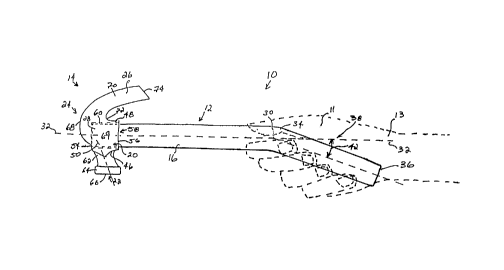Some of the information on this Web page has been provided by external sources. The Government of Canada is not responsible for the accuracy, reliability or currency of the information supplied by external sources. Users wishing to rely upon this information should consult directly with the source of the information. Content provided by external sources is not subject to official languages, privacy and accessibility requirements.
Any discrepancies in the text and image of the Claims and Abstract are due to differing posting times. Text of the Claims and Abstract are posted:
| (12) Patent: | (11) CA 2208951 |
|---|---|
| (54) English Title: | ERGONOMIC HAND TOOL |
| (54) French Title: | OUTIL A MAIN ERGONOMIQUE |
| Status: | Expired |
| (51) International Patent Classification (IPC): |
|
|---|---|
| (72) Inventors : |
|
| (73) Owners : |
|
| (71) Applicants : |
|
| (74) Agent: | ADE & COMPANY INC. |
| (74) Associate agent: | |
| (45) Issued: | 2003-10-07 |
| (22) Filed Date: | 1997-06-27 |
| (41) Open to Public Inspection: | 1998-12-27 |
| Examination requested: | 2002-06-25 |
| Availability of licence: | N/A |
| (25) Language of filing: | English |
| Patent Cooperation Treaty (PCT): | No |
|---|
| (30) Application Priority Data: | None |
|---|
The ergonomically improved hand tools include an improved handle which has a handle grip portion set at an angle to the tool head. The angle at which the handle grip is set to the remainder of the tool handle is a compound angle arranged such that the handle grip portion extends laterally of the remainder of the handle and angles downwards vertically into the hand when being gripped. This compound angle has the benefits of the Bennett handle as well as brings the tool head into alignment with the forearm of the individual using the handle which the Bennett handle fails to do. The improved hand tool handle is adaptable for use with most currently used hand tools and may be employed in any application where its use would be appropriate. The ergonomically improved hand tools provide an ergonomically redesigned hammer having the improved handle which reduces the risk of repetitive strain injuries. An extended fulcrum point is located at the top of the hammer head for improving the nail extracting characteristics of the hammer claw. The hammer claw has claw members that are angled relative to one another enabling the claw to access nails located in corners, along baseboards and at other locations where two surfaces meet at an angle. The hammer handle as well as the improvements discussed above includes the further improvement of being made from laminated materials which increases the strength of the hammer handle and helps dampen vibration. An improved paint brush and scissors are also provided. Both the paint brush and the scissors include the improved handle arrangement.
Les outils à main ergonomiques améliorés incluent un manche amélioré qui a une poignée fixée selon un angle par rapport à la tête de l'outil. L'angle selon lequel la poignée est fixée sur le reste du manche de l'outil est un angle composé, arrangé tel que la poignée s'étend latéralement par rapport au reste du manche et est inclinée vers le bas verticalement dans la main lorsqu'elle est tenue. Cet angle composé possède les avantages de la poignée Bennett et dispose la tête de l'outil dans l'alignement de l'avant-bras de l'individu à l'aide de la poignée, ce que la poignée Bennett ne fait pas. Le manche amélioré de l'outil à main est adaptable pour une utilisation avec la plupart des outils à main utilisés actuellement et peut être employé dans n'importe quelle application où son utilisation serait appropriée. Les outils à main ergonomiques améliorés fournissent un marteau redessiné de manière ergonomique équipé du manche amélioré qui réduit le risque de microtraumatismes répétés. Un point d'appui prolongé est situé en haut de la tête de marteau pour l'amélioration des caractéristiques d'extraction de clous de la griffe du marteau. La griffe du marteau possède des membres de griffe qui sont inclinés l'un par rapport à l'autre, permettant à la griffe d'accéder aux clous situés dans les coins, le long des plinthes et à d'autres endroits où les deux surfaces se rencontrent selon un angle. Le manche du marteau ainsi que les améliorations susmentionnées comportent l'amélioration supplémentaire d'être faite de matériaux stratifiés qui augmentent la solidité du manche du marteau et permettent d'amortir les vibrations. Un pinceau et des ciseaux améliorés sont également fournis. Le pinceau et les ciseaux incluent tous deux l'arrangement de manche amélioré.
Note: Claims are shown in the official language in which they were submitted.
Note: Descriptions are shown in the official language in which they were submitted.

For a clearer understanding of the status of the application/patent presented on this page, the site Disclaimer , as well as the definitions for Patent , Administrative Status , Maintenance Fee and Payment History should be consulted.
| Title | Date |
|---|---|
| Forecasted Issue Date | 2003-10-07 |
| (22) Filed | 1997-06-27 |
| (41) Open to Public Inspection | 1998-12-27 |
| Examination Requested | 2002-06-25 |
| (45) Issued | 2003-10-07 |
| Expired | 2017-06-27 |
| Abandonment Date | Reason | Reinstatement Date |
|---|---|---|
| 1999-06-28 | FAILURE TO PAY APPLICATION MAINTENANCE FEE | 2000-06-27 |
| 2003-06-27 | FAILURE TO PAY APPLICATION MAINTENANCE FEE | 2003-07-11 |
Note: Records showing the ownership history in alphabetical order.
| Current Owners on Record |
|---|
| SCHOOR, WOLFGANG |
| Past Owners on Record |
|---|
| None |